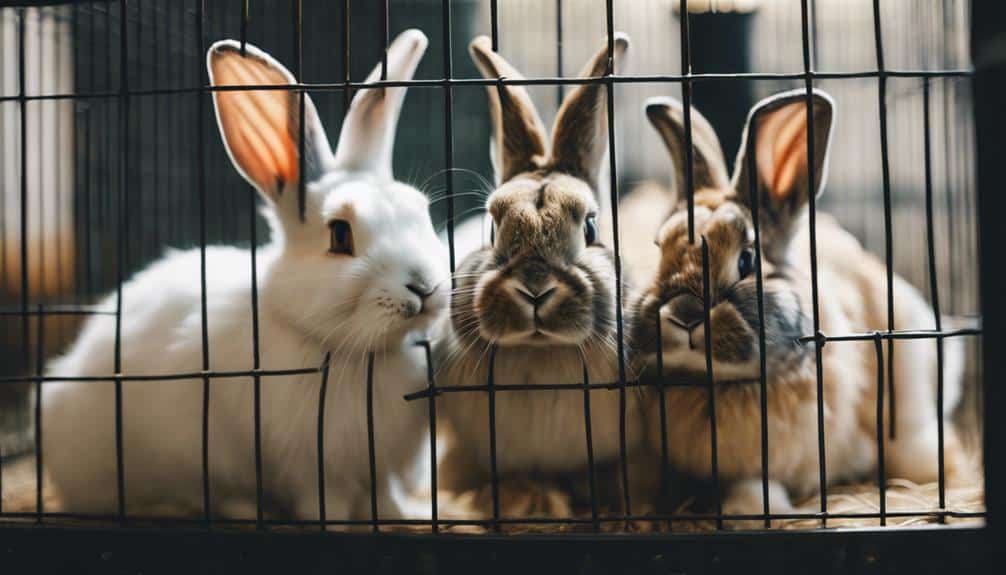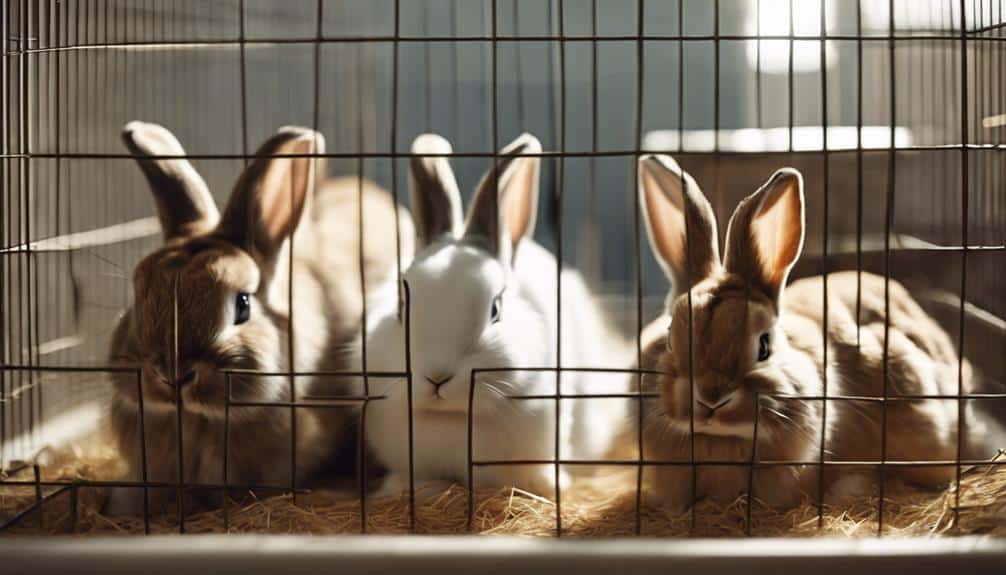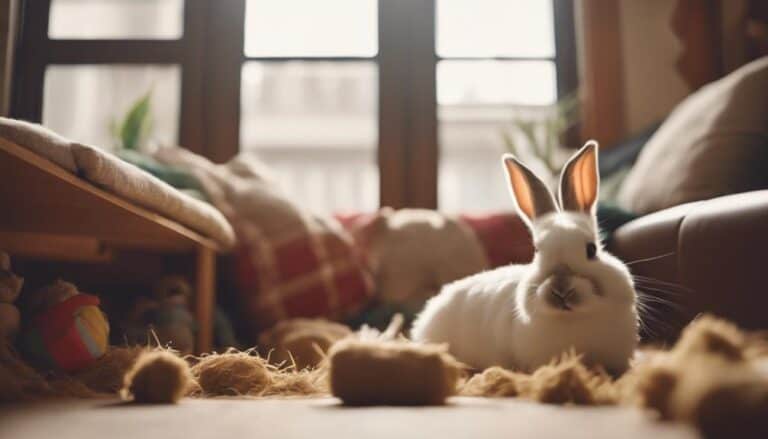If you're thinking of housing two female rabbits together, you need to consider some important factors. Their well-being and compatibility depend on understanding their behavior and introducing them to each other properly.
But there's more to it than just introducing them correctly. Their individual personalities and instincts can also influence their ability to bond. Some rabbits just get along, while others don't.
Exploring the complexities of female rabbit dynamics can help you understand the potential challenges and rewards of having them share a cage.
You'll need to consider things like dominance, territorialism, and even breeding instincts.
Contents
Key Takeaways
So you're wondering if two female rabbits can live in the same cage? The short answer is yes, but it requires some effort and planning.
First, you'll need to introduce them slowly and under supervision. This will help prevent any initial conflicts. Also, spaying your rabbits can really help reduce aggression and territorial behavior, making it easier for them to live together.
Next, make sure you provide a spacious cage with plenty of resources, such as food, water, and hiding places. This will help prevent conflicts over limited resources.
To encourage bonding, start with short, supervised interactions. This will help them get used to each other's presence and scent. It's essential to monitor their behavior and body language during these interactions. If you notice any signs of aggression or fear, it's best to separate them immediately.
By following these steps, you can create a harmonious living arrangement for your female rabbits. Just remember to stay vigilant and make adjustments as needed.
Spaying and Neutering Female Rabbits
Spaying or neutering female rabbits is essential for their well-being and living harmoniously with other rabbits. This simple procedure reduces aggression and territorial behavior, prevents unwanted breeding, lowers the risk of hereditary problems, and promotes responsible rabbit care.
The cost of spaying or neutering female rabbits is relatively affordable, ranging from £40 to £100. This is a small price to pay for the benefits it brings to your pets' behavior and health.
In addition to the behavioral benefits, spaying or neutering female rabbits also prevents health issues like uterine cancer and infections, which are common in intact females. To ensure a smooth and peaceful coexistence between female rabbits, it’s recommended to spay or neuter them before introducing them to each other. Furthermore, spaying or neutering can help reduce territorial aggression, making it easier for rabbits to bond. When considering neutered and unneutered bunny interactions, monitoring their behavior is crucial to prevent conflicts. By taking these steps, owners can foster a harmonious environment for their pets and promote healthier relationships among them.
Slow and Supervised Introductions
So, you want to introduce two female rabbits to each other without any drama. The key is to do it slowly and under close supervision. When you're introducing them for the first time, you need to take it easy and follow a step-by-step approach.
First, set up a neutral area where neither rabbit has been before. This helps prevent territorial aggression and reduces the chances of conflicts. Think of it like a neutral zone where they can meet without feeling like they need to defend their turf.
Now, let the rabbits interact in this neutral space while you keep a close eye on them. Pay attention to how they behave during this initial meeting. If you notice any signs of aggression or mounting, it's time to intervene. If things get nasty, separate them and try again later.
The goal is to get them used to each other's presence gradually. Repeated, short interactions in the neutral area can help them establish a hierarchy without resorting to aggression. It might take some time and patience, but it's worth it in the end.
Monitoring Behavior and Body Language

Monitoring your female rabbits' behavior and body language during introductions is crucial for a smooth integration. Since rabbits are social animals, they mainly communicate through body language. So, it's essential to keep an eye out for signs of stress, fear, or aggression, like thumping, growling, or hiding.
When observing your rabbits, pay attention to their posture, facial expressions, and ear positions. Relaxed rabbits usually have calm, open faces and ears held high. If you notice any changes in their appetite, stool quality, or hiding behavior, it might be a sign of stress or anxiety. This means you'll need to make some adjustments to their environment or social interactions.
During feeding times, watch out for signs of food-related aggression or competition. You can address these issues by implementing strategies like scatter feeding or providing separate feeding areas. By closely monitoring these behaviors, you'll be able to identify dominance or submission dynamics. This allows you to step in early and create a harmonious living environment for your female rabbits.
Successful Bonding Techniques
So, you want to bond two female rabbits together? It's doable, but you need to do it right.
First, you'll want to create a positive environment where they can get used to each other without feeling threatened. One way to do this is to keep them in separate but adjacent enclosures at first. This way, they can see, smell, and even interact with each other without being in the same space.
As they get more comfortable with each other, you can start introducing them to each other in short, supervised sessions in a neutral area. Keep a close eye on their body language during these sessions. If they seem relaxed and aren't showing any signs of aggression, that's a good sign.
You can even offer them treats when they're being calm and friendly towards each other. This can help strengthen their bond over time.
The key to successfully bonding two female rabbits is patience. Don't rush the process, and make sure you're providing a safe and positive environment for them. If you do it right, they'll have a much better chance of living happily together in the same enclosure.
Understanding Rabbit Behavior and Needs

To take good care of rabbits and keep them happy and healthy, you need to understand their behavior and needs. Rabbits are social animals that thrive on companionship, but introducing two female rabbits to each other can be tricky.
If you're thinking of getting two female rabbits, you need to be careful. They can start fighting as early as 4-6 months old, especially if they're from pet shops and might be sisters.
So, it's crucial to introduce them slowly and keep a close eye on them to prevent conflicts.
Providing plenty of space and resources like food, water, and shelter can help reduce aggression. Spaying or neutering them can also decrease aggression and improve their compatibility.
But monitoring their behavior is key. You need to be prepared to separate them if necessary.
Understanding the social dynamics and needs of female rabbits is vital for creating a harmonious living environment and ensuring their well-being.
Conclusion
With the right approach, two female rabbits can definitely live together in the same cage. The key is to spay or neuter them, introduce them slowly, and keep an eye on their behavior. This way, you can help them develop a strong and healthy bond.
It's not something that happens overnight, though. Building a good relationship between rabbits takes time, effort, and understanding. You need to be patient and let them get used to each other at their own pace.
But if you're willing to put in the work, you'll be rewarded with a beautiful friendship between your two furry companions. They'll become inseparable, just like two peas in a pod.






